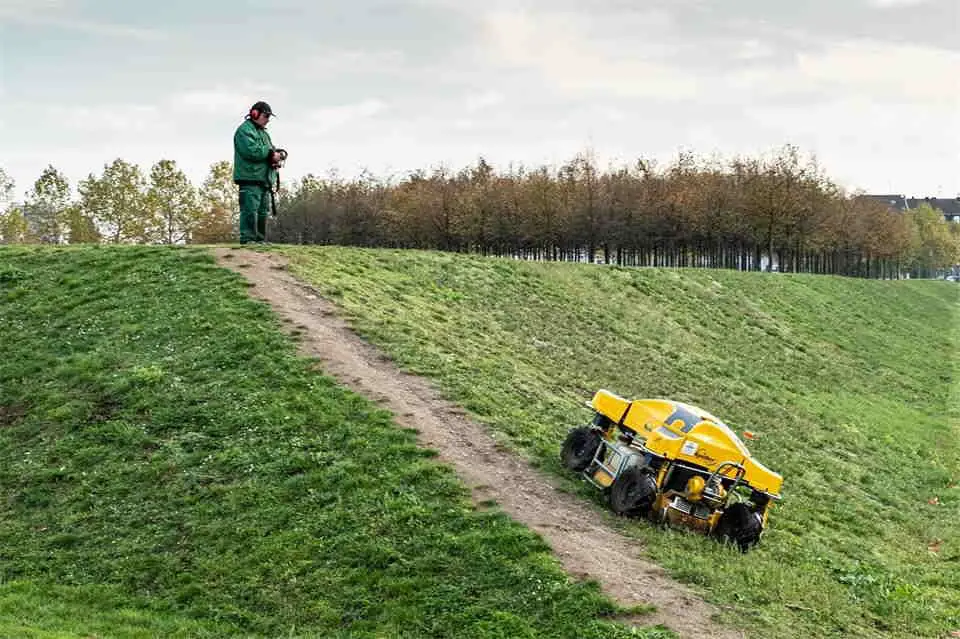Lifesytle
How Lawn Care Teaches Patience, Persistence, and Growth


Maintaining a lush, green lawn is more than just an aesthetic pursuit—it’s a journey that teaches valuable life lessons. If you’ve ever spent time mowing, watering, weeding, and fertilizing, you know that lawn care is a process that requires patience, persistence, and a deep understanding of growth.
Whether you’re a seasoned homeowner or a first-time gardener, the practice of lawn care can help you develop important qualities that extend beyond your yard and into everyday life.
The Power of Patience
One of the first things you learn when caring for a lawn is that results don’t happen overnight. You can plant the best grass seed, provide the ideal nutrients, and water consistently, but you still have to wait for the grass to grow.
This waiting period teaches an invaluable lesson in patience. Much like in life, success in lawn care is a slow and steady process. There are no shortcuts to a beautiful, healthy lawn—it takes time for roots to establish, for bald patches to fill in, and for weeds to be managed.
Just as you can’t rush the growth of your lawn, you can’t always rush success in other areas of life. Patience is essential whether you’re working toward a personal goal, learning a new skill like mastering an instrument, or developing a career. Lawn care reminds us to embrace the process rather than just focusing on the outcome.
The Importance of Persistence
Lawn care is not a one-time effort—it’s a continuous cycle of maintenance. You have to keep up with mowing, weeding, aerating, and feeding the soil. Then there is taking care of the flower beds. If you neglect your lawn for even a short period, weeds can take over, grass can dry out, and pests can wreak havoc.
This constant need for upkeep instills persistence. You quickly learn that a thriving lawn isn’t achieved through a single burst of effort but through regular, dedicated work. This same mindset applies to personal and professional endeavors.
Whether it’s building a business, improving fitness, or strengthening relationships, success comes from consistent effort over time.
Even setbacks—like a patchy lawn after a drought or a yard full of weeds after a vacation—serve as reminders that challenges are inevitable. However, with persistence, those challenges can be overcome. Adjustments may need to be made, but as long as you keep showing up and putting in the effort, progress will happen.
Understanding Growth and Adaptation
A healthy lawn is a constantly evolving ecosystem. Grass grows at different rates, weather conditions change, and new challenges arise with each season. To maintain a thriving lawn, you must learn to adapt.
For example, if you notice brown spots appearing, you must investigate whether it is a lack of water, a nutrient deficiency, or a pest problem? Addressing issues requires both knowledge and the willingness to adjust your approach.
This mirrors personal growth in many ways. Life isn’t static, and neither is success. You must be willing to learn, make changes, and experiment to find what works best for your circumstances. Lawn care teaches that growth is a dynamic process that requires continuous learning and adaptation.
Tools that Make the Journey Easier
While lawn care requires patience and persistence, having the right tools can make the process smoother and more efficient. Investing in high-quality equipment, such as zero-turn mowers, can help make mowing more precise and less time-consuming.
Similarly, in life, having the right tools—whether it’s knowledge, mentorship, or resources—can make achieving success easier and more enjoyable.
Finding Fulfillment in the Process
Beyond the practical benefits of a well-maintained lawn, there is something deeply satisfying about watching your hard work pay off. Seeing a patchy yard transform into a lush, green space is incredibly rewarding.
This fulfillment extends beyond lawn care into other aspects of life. When you work hard toward a goal—whether it’s a fitness milestone, a professional achievement, or a personal project—the satisfaction of seeing progress is unmatched. Lawn care serves as a tangible reminder that effort leads to results, reinforcing that persistence and patience pay off.
Conclusion
Lawn care is more than just a weekend chore—it’s a lesson in patience, persistence, and growth. It teaches us that success takes time, that consistent effort is necessary, and that adapting to challenges is crucial. These same principles apply, whether you’re tending to your lawn or working toward a personal goal.
So the next time you’re out mowing, watering, or weeding, remember that you’re not just maintaining a yard—you’re cultivating valuable life skills.
Lifesytle
Legacy Living: How the Elderly Can Inspire Generational Change


As society continues to evolve, one constant remains: the wisdom of our elders. Often underestimated or overlooked, older generations hold the key to values, stories, and life lessons that can shape the future.
The idea of legacy living is more than just passing down wealth or heirlooms, it’s about inspiring positive change across generations through lived experience, resilience, and insight.
Redefining Legacy in Modern Times
Legacy is no longer defined only by the material things we leave behind. Today, it includes emotional, ethical, and cultural contributions. The elderly, through their unique life experiences, have the power to influence younger generations in ways that go far beyond tradition.
Whether it’s through storytelling, mentorship, or quiet acts of courage and kindness, the impact can last far longer than physical possessions.
In an age dominated by fast-paced technology and short attention spans, the elderly offer something rare: perspective.
They’ve witnessed social changes, survived economic downturns, seen families and communities grow and evolve, and learned the importance of patience and perseverance. These insights can guide younger generations to lead more balanced, thoughtful lives.
The Power of Storytelling
One of the most compelling ways the elderly can influence generational change is through storytelling. Personal narratives carry emotional depth that facts and figures cannot. A grandfather recounting his experiences during wartime, or a grandmother describing how she raised a family during difficult times, offers lessons in strength, sacrifice, and hope.
These stories become powerful tools that teach empathy and gratitude. For younger people, especially those growing up in more comfortable or digital environments, hearing about the challenges of past generations can cultivate a sense of humility and respect.
It helps them understand the broader human experience and gives context to their own struggles and triumphs.
Mentorship and Role Modeling
Older adults can also serve as mentors—whether formally, through volunteer programs or educational settings, or informally within families and communities. Their role as advisors helps bridge the generational gap, offering practical wisdom while also validating the importance of younger voices.
Many seniors thrive in mentorship roles, finding a renewed sense of purpose in helping others navigate life’s challenges. From career advice to coping with loss, older mentors can offer guidance rooted in personal experience rather than theory. This type of intergenerational connection fosters mutual respect and understanding, building stronger communities in the process.
For example, care communities like this Bury St Edmunds care home often encourage intergenerational activities, bringing together residents and local students or youth groups. These encounters lead to meaningful conversations and shared learning moments, showing that the elderly aren’t just recipients of care but also providers of wisdom and inspiration.
Values That Transcend Time
Another key component of legacy living is the transmission of values. Integrity, kindness, perseverance, and responsibility—these qualities are often embodied by older adults who’ve weathered life’s storms. By living these values and modeling them for others, they leave a legacy that influences how future generations behave and interact with the world.
In a world that sometimes seems driven by instant gratification, such enduring values are a grounding force. When younger individuals see their elders demonstrating patience, humility, or generosity, those traits are more likely to be carried forward.
Practical Ways to Share Legacy
Legacy doesn’t have to be abstract. There are practical ways that the elderly can inspire generational change:
- Writing memoirs or letters: Even simple reflections or advice written down can become treasured keepsakes.
- Volunteering: Sharing time and expertise in schools, libraries, or community centers creates direct, positive impact.
- Hosting family traditions: Holidays, recipes, and rituals provide continuity and connection.
- Recording oral histories: Many organizations help document personal stories that enrich community history and family identity.
Even a simple afternoon spent talking to grandchildren about past struggles or joys can leave a lasting impression. The act of sharing encourages curiosity and dialogue, both of which are essential for growth across generations.
Changing How Society Views Aging
To fully realize the potential of legacy living, society must shift its view of aging. Older adults should not be seen solely as dependent or fragile. Rather, they’re reservoirs of experience, mentors-in-waiting, and cultural touchstones.
Supporting environments where the elderly can thrive—emotionally, mentally, and socially—is essential. That means providing access to stimulating activities, opportunities for connection, and platforms to share their stories. When older individuals feel valued, they’re more likely to engage and contribute in meaningful ways.
A Lasting Influence
Legacy isn’t about achieving fame or recognition; it’s about planting seeds for a better future. The elderly, through their actions, choices, and interactions, shape how future generations think, feel, and act. Their influence is subtle but powerful—a quiet force for compassion, strength, and progress.
Encouraging intergenerational connections, listening to older voices, and celebrating their contributions will ensure that their legacies live on, not just in memory, but in the hearts and minds of those who follow.
In a world that’s constantly looking forward, sometimes the most important direction is to look back—and learn.
Beauty
Tips for Looking After Your Skin When You Have a Big Trip Lined Up


Getting ready for a big trip is always exciting, whether it’s a beach vacation, a city getaway, or an adventure abroad. Amid all the planning and packing, don’t forget about one important point: your skin. Travel, especially long flights or exposure to different environments, can take a toll on your complexion.
Fortunately, with a little foresight and attention to your skincare routine, you can ensure that your skin stays healthy, hydrated, and radiant throughout your journey. Here are some helpful tips to keep your skin looking its best.
Hydrate
One of the most common skin issues people face when traveling is dehydration. Whether you’re flying in an airplane, spending time outdoors in a hot climate, or dealing with changes in humidity, dehydration can cause your skin to appear dull, dry, and prone to irritation.
To combat this, drink plenty of water leading up to your trip and during your travels. It’s important to stay hydrated on a daily basis, especially in the days before your trip, to help keep your skin plump and glowing.
If you’re flying, consider using a hydrating facial mist during your flight to maintain moisture levels. Additionally, avoid alcohol and caffeinated drinks, as they can dehydrate your body and skin.
Protect Your Skin from the Sun
Whether you’re traveling to a tropical destination or exploring a new city, sun protection is crucial. Long exposure to UV rays can lead to premature aging, sunburn, and damage to your skin’s texture. Before heading out, always apply a broad-spectrum sunscreen with SPF 30 or higher.
If you’re going to be outdoors for extended periods, reapply sunscreen every two hours, especially if you’re swimming or sweating. Don’t forget to protect often-missed areas such as the ears, back of the neck, and the underside of your hands.
Stick to a Simple Skincare Routine
When traveling, it’s easy to neglect your usual skincare routine due to time constraints, unfamiliar environments, or a change in your surroundings. However, consistency is key to maintaining healthy skin, even when on the go.
You don’t need to bring your entire skincare collection with you, but it’s essential to keep your routine simple and effective. Focus on the basics: cleanse, hydrate, and protect. A gentle, hydrating cleanser, a lightweight moisturizer, and your sunscreen are non-negotiable.
Preemptively Treat Skin Concerns
If you’re prone to acne, sensitivity, or any other skin issues, make sure to address them before your trip. Traveling, particularly flying, can sometimes trigger breakouts or exacerbate skin sensitivities.
To prevent this, consider booking a facial or skin treatment prior to your departure. Professional treatments, such as a hydrafacial or microdermabrasion, can give your skin a healthy boost and help you start your trip with a clear and glowing complexion.
One place that can help you prepare your skin for travel is dermani MEDSPA. They offer a variety of skincare treatments designed to rejuvenate and refresh your skin, leaving you looking your best before you jet off. Their professional staff can provide expert advice on how to get your skin in optimal condition for the rigors of travel.
Bring Travel-Friendly Skincare
Airport regulations often restrict the amount of liquid you can bring in your carry-on, but that doesn’t mean you have to sacrifice your skincare routine.
Invest in travel-sized versions of your favorite skincare products or purchase reusable travel containers to fill with your essentials. Look for multi-purpose products that can save space, such as a moisturizer with built-in SPF or a cleanser that doubles as a makeup remover.
For the dry airplane cabin, packing a rich, nourishing lip balm and a hand cream can help keep those often-neglected areas hydrated. Additionally, you might want to bring a soothing face mist to refresh your skin during your flight.
Be Mindful of the Local Climate
Every destination has its unique climate, and it’s important to adjust your skincare routine accordingly. If you’re traveling to a dry or hot climate, you may need a heavier moisturizer or an oil-based serum to lock in hydration. On the other hand, if you’re heading to a more humid destination, opt for lightweight, oil-free products to avoid clogged pores.
In areas where the air is dry or cold, like high altitudes or snowy destinations, add an extra layer of moisture to your routine to prevent your skin from becoming parched. Consider using a rich overnight mask or a nourishing oil to keep your skin feeling soft and smooth.
Avoid Stressing About Skin Imperfections
Finally, remember that travel can be stressful, and it’s normal to experience the occasional breakout, redness, or irritation. Don’t stress about your skin, as it’s important to enjoy your trip and not let minor skin issues overshadow the experience.
If you feel your skin is acting up, stick to your basic routine, drink lots of water, and try to get enough sleep. Often, stress and lack of rest can trigger skin flare-ups, so be kind to yourself and give your body the rest it needs.
Lifesytle
Unplug, Unwind, Understand: The Life Lessons Found in Island Silence


When was the last time you truly heard nothing? Not the buzz of your phone. Not the hum of traffic outside your window. Not the constant background noise of an always-on world. Just silence — real, enveloping, expansive silence.
It’s an experience that’s becoming increasingly rare, but it still exists in pockets of the planet where nature commands attention and connection requires more than Wi-Fi.
One of the most profound places to encounter this kind of silence is on a remote island, where the absence of noise isn’t an emptiness but a powerful presence. Within that stillness, life lessons rise to the surface — quiet but undeniable.
The Power of Island Silence
Stepping onto an island far from the clamor of daily life is a bit like stepping into a time capsule — everything slows down. There are no blaring horns, no packed schedules, no overflowing inboxes.
The silence of the ocean, broken only by waves lapping at the shore or the occasional call of a bird, forces you to feel rather than react, observe rather than scroll, and listen to the world around you and within you.
On islands such as those scattered across the Indian Ocean, this silence becomes a teacher. It teaches you to embrace the space between doing and simply being. The serenity of nature becomes not just a setting, but a catalyst for clarity.
Lesson One: Detachment Brings Clarity
People often underestimate how deeply their sense of identity is tied to their devices, their routines, and their environments. Removing yourself from that noise — both literal and metaphorical — gives you the opportunity to ask: Who am I without all of this?
On an island, without the distractions of constant notifications, it becomes easier to separate your wants from your habits. You rediscover your internal compass.
What brings you joy when no one is watching? What kind of rhythm does your day take when it’s guided by sunlight and tides rather than alarms and deadlines? It’s in this detachment that clarity emerges. You begin to see your life — and your place in it — with fresh eyes.
Lesson Two: Presence is a Practice
Silence teaches you to be present, but presence doesn’t come naturally to most of us anymore. It’s a muscle we have to exercise. At first, the absence of stimulation may feel unsettling. After a while, you start noticing things you hadn’t before — the textures of sand beneath your feet, the sound of your own breath, the changing hues of the sky at dusk.
Being fully present means letting go of control. Islands are good at enforcing that. Weather patterns change without notice, boats arrive when they can, and schedules bend to nature’s timing. In letting go, you learn to trust and surrender — not in a passive way, but in a deeply active one. It’s a presence that demands attention and patience.
Lesson Three: Nature Is Not a Luxury
In the middle of a quiet island surrounded by turquoise waters and lush vegetation, you realize that nature is not a luxury or a reward but a necessity. People often relegate nature to something they visit occasionally, rather than something they are inherently a part of.
Islands reframe this perspective. The ocean reminds you of your smallness and your significance. The stars — more vivid without light pollution — call your attention to how much beauty is missed when you’re rushing from one obligation to another.
Planning a trip to reconnect with nature and silence doesn’t have to be out of reach. There are numerous breathtaking resorts in Maldives Islands where you can immerse yourself in this kind of stillness. These places offer more than just luxury — they offer space, silence, and the permission to slow down.
Lesson Four: Simplicity is Abundance
Perhaps one of the most surprising lessons learned in island silence is that a simpler life is not a lesser life. It’s easy to associate luxury with complexity — gourmet meals, packed itineraries, high-end amenities. But on an island, abundance is redefined. It’s found in long, quiet mornings.
In fresh fruit eaten under the shade of a palm tree. In barefoot walks where each step connects you more deeply to the earth. Stripped of excess, you come to appreciate the essentials: time, connection, health, rest. What once felt like “not enough” becomes more than plenty.
The Takeaway: Return Changed
Island silence is not just a break from routine — it’s a recalibration. When you return, you bring back more than souvenirs or sun-kissed skin. You carry a quieter mind, a more open heart, and a clearer understanding of what truly matters.
In a world that celebrates noise, hustle, and performance, choosing silence is a radical act. But within that silence lies truth, healing, and a reconnection to the self. The island may be far away, but the lessons it offers are ones you can carry with you — if you listen closely enough.
So, unplug. Unwind. And understand. The silence isn’t empty — it’s full of wisdom waiting to be heard.
-



 Quotes5 years ago
Quotes5 years ago125 Inspirational Car Quotes and Captions to Celebrate Your New Car
-



 Growth5 years ago
Growth5 years ago188 Deep Hurt Quotes with Images
-



 Quotes4 years ago
Quotes4 years ago148 Romantic Love Quotes for Her from the Heart
-



 Quotes4 years ago
Quotes4 years ago164 Relationship Goals Quotes for New Couples Expecting a Long Lasting Relationship
-



 Quotes4 years ago
Quotes4 years ago185 Cute Boyfriend Quotes for the Guy You Love
-



 Quotes4 years ago
Quotes4 years ago141 Best Heart Touching Quotes about Love, Life, and Friendship
-



 Quotes4 years ago
Quotes4 years ago134 Time Flies Quotes for the Unforgettable Moments
-



 Quotes4 years ago
Quotes4 years ago122 Inspirational Kite Quotes That’ll Make You Wanna Fly Right Now






